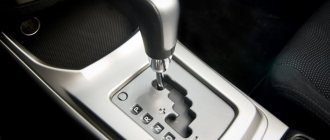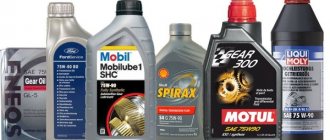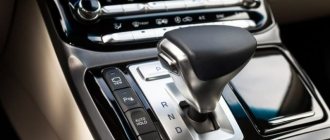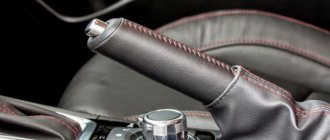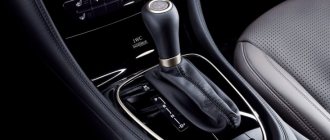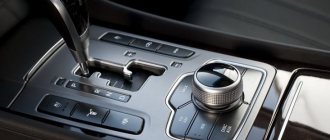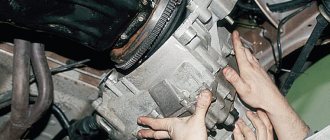The automatic transmission is a much more popular type of transmission today for a number of reasons. First of all, this type of gearbox greatly simplifies the process of driving a car, driving becomes more comfortable and safe, since the driver is not distracted by changing gears, errors when choosing a gear, etc. are eliminated.
At the same time, it is also well known that an automatic transmission is a complex and “capricious” unit compared to a manual transmission. Naturally, the more complex the device, the greater the likelihood of serious breakdowns.
However, in practice it often happens that one driver’s reliable manual transmission fails earlier than another’s automatic transmission. In this article we will talk about the service life of the automatic transmission, as well as what factors and features directly affect the service life of the automatic transmission.
Kia Spectra II
The second generation of Kia Spectra was produced from 2004 to 2008. Now they are asking 207 thousand rubles for it on average.
Officially in our country, one engine option was offered with an automatic transmission - 1.6 liters with a capacity of 101 hp. With. The transmission on the Spectrum is the same as that on the Accent, but the performance properties of the transmissions manifest themselves differently. Among the widespread negative reviews of the Spectra automatic transmission is the periodic appearance of vibration and jerking when switching. Planetary gears often howl and clutches wear out. Also, the automatic machine does not tolerate overloads, for example, when towing or using super-heavy trailers.
The Spectra's equipment is at the level of other models in the rating: driver's airbag, electric windows, air conditioning, heated seats and mirrors.
The model is old, so most of the “Spectrum” are sold with a duplicate title, after an accident, with an estimate of repair work and a twisted mileage.
There are models with unpaid fines and a taxi driver's past:
The chance of buying a problem-free car is high. Every third Kia Spectra is sold as “clean”.
Robotic box and its resource
The robot gearbox is actually an automated manual gearbox. In theory, this gearbox should have received the simplicity and reliability of a manual transmission combined with the convenience of an automatic transmission. However, in reality this did not happen. Moreover, it is robots that have the lowest resource.
Robotic gearboxes today are found in two versions - automated manual transmission (AMT) and preselective dual-clutch gearboxes. In the first case, the gearbox receives servos and actuators to automate the functions of selecting and on/off gears, as well as on/off the clutch.
So, the box itself usually does not cause problems, but quite quickly problems arise with the clutch assembly, as well as with the specified servomechanisms. It is these elements of the robot that “walk” no more than 80-120 thousand km, and even then in a gentle operating mode.
Let's move on. To bring the robot as close as possible to an automatic transmission in terms of smooth gear shifting, manufacturers have released a preselective gearbox with two clutches (for example, the well-known DSG).
This robot is a combination of a classic automatic transmission and a manual transmission. It is based on the same manual transmission, which has two shafts and two clutches, respectively. One shaft is responsible for even gears, while the other is responsible for odd ones.
While the car is moving in one gear, the next one is already selected. This made it possible to reduce the switching moment to a minimum. The driver practically does not feel when the gear is shifted “up” or “down”. This design made it possible to achieve outstanding performance in terms of acceleration dynamics, fuel efficiency, comfort, etc.
At the same time, the design also contains a hydraulic unit (mechatronics), the preselective robot requires more oil and regular maintenance. First of all, the reliability of clutch discs is not high; problems often arise with mechatronics, electronics, actuators, etc.
The service life of robotic gearboxes with double clutches in practice does not exceed 100-150 thousand km, after which it is often necessary not only to replace the clutches, but also the valve body and other elements. At the same time, the cost of spare parts and labor is quite high, often comparable to high-quality repairs of a “classic” automatic transmission.
Toyota RAV4
Both the Toyota Camry business sedan (seventh place in the ranking) and the Toyota RAV4 crossover are the two most popular cars from Toyota with automatic transmission, they alone account for more than 60% of sales.
The Toyota RAV4 (fourth generation) was generally the leader among Russian crossovers for several years, but now it has been supplanted by the KIA Sportage and Volkswagen Tiguan. Experts say that the reason is simple - the rise in price of Toyota. However, at the end of last year a new, improved model entered the Russian market, which seems to have increased the rating of the Toyota RAV4, at least among owners of an automatic transmission.
Currently, the fifth generation on the Russian market has a 2.0 or 2.5 liter engine, two transmissions - a CVT or an eight-speed hydromechanical - and two drive options (they differ in the number of clutches in the rear wheel drive).
Option to change transmission type from manual to automatic
The process of installing an automatic transmission in place of a manual transmission is more complex and requires significant costs. This requires serious intervention in the ECM, installation and configuration of additional sensors and unit controllers, and in some cases, changing the design of the cardan cover. The main list of components for installing the machine and connecting:
- Radiator cooling circuit cooling grille, oil lines and tubes
- A set of a new cable selector drive with wiring, connectors on the ECU, sensors and controllers (in practice, a complete replacement of all electrical wiring elements on the automatic transmission)
- Special control unit for automatic transmission, relays with fuses
- Starter, pedal drive assembly
- New speedometer sensor with relay
- Reversing lights with wiring and connection to the ECU (braid type)
- Shock-absorbing cushions in fastening elements (only on foreign cars)
- Torque converter assembly (if not included)
- Bottom driveshaft cover (on some models)
- Consumables for the support (gaskets, seals, seals)
Automatic drive unit.
Operating procedure:
- Complete dismantling of the manual transmission with disconnection of the clutch units (similar to the automatic transmission).
- Removing the selector assembly and pedals with drive (cylinder, link, brackets).
- Disconnecting and disassembling the hydraulics and oil pipeline (draining the working fluid)
- Removing the crankshaft flywheel and starter.
- After completely removing all mechanical elements, first install a new starter, electronic control unit and change the wiring lines with the connection of sensors.
- The cooling radiator grille is installed in parallel with the rear support under the power unit (using shock-absorbing damper components where provided for by the design of the box).
- The cardan shaft is changed depending on the car model (usually for older car brands that were equipped with an automatic transmission, this is not necessary)
- Mount the automatic transmission in place using brackets.
- Connect and install the selector and pedal assemblies with drives.
- They configure the ECU with flashing, ensuring that the electrics work for all sensors, a reversing light, a fuse, an oil pump and a speedometer.
Difficulties in conversion may arise with the installation of the center console in the cabin - the selector drive unit and its location in the cabin on automatic machines have significant design differences.
How to distinguish a robot from an automatic or CVT
The fact is that manufacturers strive to simplify as much as possible the entire process of interaction between the driver and the gearbox. For this reason, for example, a robot may have the same selector and modes (PRND) as a CVT or automatic transmission.
As for the driving sensations (provided that the transmission and the car itself are in full working order), you can pay attention to the following:
For this reason, it is recommended to study the vehicle manual separately to determine exactly what type of transmission is installed on a particular model.
In general, pay attention to the following instructions:
- AT - often means hydromechanical automatic;
- CVT - variable speed transmission;
- AMT - robotic gearbox with one clutch;
You can also visit specialized auto forums, study technical literature separately, etc.
Where is the automatic transmission oil dipstick located?
In order to find out exactly where the automatic transmission oil dipstick is located, refer to your car's manual, which necessarily contains information about the location of the transmission oil dipstick. As a rule, such information is located in the “Car Maintenance” section.
Ten cheap solutions for car tuning
Here are some examples in the form of photographs in which we have marked with an orange arrow the location of the transmission oil dipstick in various cars:
Main automatic transmission breakdowns and ways to fix them
Whatever the automatic transmission, it is a technically complex unit, and it is capable of failure. The main “diseases” of Aisin boxes:
The car slips after it warms up, while the “cold” car drives normally.
This is caused by a number of reasons. One of them is a lack of oil in the box. While the car is cold, the oil has increased viscosity and density, the fluid pressure is enough to ensure normal movement. After warming up, the oil becomes more liquid, the pressure decreases, the transmission begins to “glitch”, and the car slips.
In this case, you should simply add gear oil to the Aisin gearbox to the required level.
The second possible reason is contaminated oil. Foreign elements gradually clog the box filter, and the pressure in the system decreases. To solve this problem, you will have to replace the fluid along with the filter.
The third reason is the combustion of the friction disc block.
You should remove the transmission pan, inspect the discs and piston seals, replacing them if necessary.
The box makes extraneous noise, the car does not move, or barely moves, until the oil warms up.
The main reason for this is the failure of the gearbox torque converter. The problem can only be solved by replacing the broken unit.
The car barely moves forward and does not respond to reverse gear. If you try to push the car back, you won't be able to do it.
Such symptoms indicate a breakdown of the planetary gearbox when the sun gear jams. The way to fix the problem is to replace the failed parts or repair them.
The forward gears on the box are engaged, but the reverse gears are not.
Most likely, the brake band of the box is broken and needs to be replaced.
For six-speed gearboxes: 6th gear and reverse are not engaged.
Clutch friction discs are worn. Parts should be replaced.
The transmission gear ratio changes only in the range of 3-5 thousand revolutions, and above.
This behavior is caused by a decrease in oil pressure in the system due to wear on the gearbox gears.
The car has lost its dynamics, the oil pressure in the box is reduced.
This may mean that the box filter is clogged with metal dust from automatic transmission components. The filter and possibly the oil pump should be replaced, since clogging occurs with particles from its gears.
Noise from the automatic transmission at idle.
This means that the automatic transmission torque converter blades are rattling or the discs on the transmission input shaft coupling are worn to the limit. The corresponding units need to be repaired or replaced.
The transmission hit a hard surface, after which the car stopped starting.
You should try to put the box back in its original place if it has moved. If the operation is unsuccessful, you need to adjust the gearbox control rod.
The P position on the box selector is not set.
It is necessary to adjust the automatic transmission drive, diagnose and repair the gearbox locking device.
No transmission brake.
The transmission brake needs to be repaired and the block crown pawl needs to be replaced.
After turning on N on the gearbox selector, the car moves.
The running discs are probably burnt out, or the automatic transmission drive has gone wrong. The box drive should be adjusted or the discs replaced.
The box slips on inclines.
As a rule, this indicates a low oil level; the symptom is eliminated by topping it up.
There is oil on the torque converter housing.
Most likely, the oil pump seal has leaked and should be replaced.
If you don't press the gas, the car rolls back on the slope.
The freewheel is worn out and the part needs to be replaced.
How to correctly change gears on a robot gearbox?
It’s enough to just stand for a couple of minutes with the engine running, and you don’t need to switch the selector to different modes, just keep it in the “N” position. After this, you need to start moving smoothly, without sudden jerks, and drive for at least 1 km, which will ensure complete heating of the oil.
Interesting materials:
How can I make the slide switch itself? How can I make the slides switch automatically? How can I prevent a layer from showing in one viewport? How can I make the footnotes go in order? How can I save it to disk D? How to make a link change HTML color? How to make the link not underlined in html? How can I make the page update itself? How can I make the table be on one sheet? How to make the table not go beyond the fields?
Volkswagen Tiguan
The reason for the popularity of this brand is its excellent design, solid and at the same time original, good driving performance, spacious interior, spacious trunk and electronic systems inside.
Many experts believe that the Tiguan is a kind of pinnacle of the evolution of class B crossovers. There are two engines to choose from - 1.4 liters and 2.0 liters with a volume of 150 and 180 “horses”, respectively. There are configurations with all-wheel drive and even a special option for the Russian winter - the so-called. Winter Edition with heated seats, snow and ice distance control, three-zone climate control and even a rain sensor. Apparently, the compilers of the package are familiar with Moscow winters firsthand.
Changing manual transmission to automatic transmission
Step-by-step reinstallation is performed in the following order:
- The car is raised on a jack or placed on a repair “pit” (overpass).
- Turn off the power by removing the terminals from the battery.
- The internal combustion engine components and protective panels in the cabin that block access to the transmission are dismantled.
- Remove the starter (on some car models this is not necessary - if the starter is attached to the main unit).
- Disconnect the electrical wiring to the automatic transmission and the electronic control unit (on robotic versions).
- Carefully drain the transmission oil from the box and dismantle the oil lines on the oil pump.
- The automatic transmission is removed from the support by unscrewing the mounting bolts.
- Next, the torque converter is separately dismantled along with the block.
- The flywheel is attached to the crankshaft only after the automatic machine has been completely dismantled.
- Change the selector drive to a mechanical one.
- Install the third pedal (clutch) and drive unit (cylinder).
- The manual gearbox is mounted in place of the automatic transmission using the same bolts.
- Connect the oil line pipe to the pump.
- Fill in the working fluid (oil).
To completely install a new manual transmission, you will need the following components and consumables:
- Tool kit: hexagons, drill, wrenches with adapters, screwdriver
- Selector drive for “mechanics” with a rocker
- Mechanical drive control cables
- New flywheel for crankshaft
- Clutch pedal with drive elements
- Clutch slave cylinder
- Gaskets, fasteners for the case with brackets, rubber (or silicone seals)
- Electrical wiring to the oil pump
- Electronic control unit for manual transmission with sensors and controller (not installed in later car models)
A set of components for installing a manual transmission.
After installing the manual gearbox, it is necessary to balance the flywheel and clutch basket. The starter is replaced with a new one, disconnecting it from the computer. The automatic type of transmission does not allow the forced start of the power unit when the battery is discharged - a lock is set for this in the ECM (electronic engine control system) settings. If the starting mode matches, install a regular jumper and reflash the electronic unit, removing the lock on starting from the “pusher” (towing). They also change or reflash the reversing light for manual ones.
The reverse lights need to be re-flashed for the manual transmission.
Choosing a manual transmission instead of an automatic one requires compliance with the design features for each car brand. Those units fit perfectly into their installation places; early car models were equipped with a manual transmission and were mass-produced. Some problems may arise with mounting the main body, which will require additional brackets, drilling holes for the clutch and drive pedal. Basically, changing the type of transmission is a standard procedure for an experienced auto mechanic.
The cheapest car with an automatic transmission: TOP-5 rating
So, an automatic transmission greatly simplifies the process of driving a car, since there is simply no need to constantly work with the clutch pedal, as well as correctly select and promptly change gears using the gearbox lever inside the car.
Moreover, if earlier old automatic transmissions noticeably increased fuel consumption, while the car lost dynamics, new automatic transmissions are more or less free of such shortcomings. It should also be noted that in addition to classic automatic transmissions with a torque converter, today there is also an active popularization of robotic gearboxes, as well as CVT variators.
Each of these types of automatic transmissions has both pros and cons, but the main task in the form of fully automatic gear shifting is successfully implemented in each case. Cars with automatic transmissions, robots or CVTs are offered by well-known manufacturers from Europe, South Korea, Japan or the USA, as well as manufacturers from the Russian Federation, Ukraine, Uzbekistan, China, etc.
So, let's return to the budget versions of cars with automatic transmission, which are popular in the CIS; they can be purchased new or whose age, in the case of a used one, does not exceed ten years.
The undisputed leader and at the same time a bestseller on the market was and remains the Daewoo Matiz with an automatic transmission. This compact city runabout can be equipped with a classic 4-speed Jatco automatic transmission; versions with a continuously variable CVT are also occasionally found.
As a rule, it is the hydromechanical automatic transmission that is in great demand due to its maintainability and reliability. Unfortunately, such a car cannot be purchased new, but on the secondary market you can still find versions with minimal mileage in good condition.
Next we can highlight Chery QQ, which also deservedly made it onto the list of the cheapest cars with an automatic transmission. This car is a Chinese “clone” of Daewoo Matiz, and not the most successful one.
First of all, it should be noted that, unlike Matiz, Chery QQ, along with richer equipment and a modernized interior, also received a cheap AMT-type robotic transmission. In practice, such a gearbox is noticeably inferior to classic automatic machines both in terms of reliability and comfort.
The next model in the ranking of the cheapest cars with an automatic transmission is ZAZ Lanos. The car is equipped with a “classic” four-speed automatic transmission and is sold at a very affordable price compared to its competitors.
Also, the version with automatic transmission has power steering, air conditioning, heated seats, power windows and a driver's airbag. The disadvantages include the lack of an ABS system and the outdated exterior/interior of the car.
Next we should mention Ravon R2, which is a new product from Uzbekistan. In fact, Ravon P2 is a slightly modified Chevrolet Spark (Chevrolet Spark).
This car is equipped with a “classic” hydromechanical automatic transmission and can rightfully be considered a full-fledged Daewoo Matiz receiver. As of today, this car remains the cheapest car with a full automatic transmission.
The Citroen C1 model completes the list of the cheapest and most popular cars with an automatic transmission. The car received a good level of equipment, as well as active and passive safety.
The box on this machine is robotic, the robot itself is single-disc. As practice shows, such an automatic robot is more suitable for a calm and leisurely drive around the city.
If the driver practices a more active driving style, then one should expect jerks, jolts and delays when switching. Also, the service life of such a robot is less than that of an automatic transmission or even a CVT, and repairs cannot be called cheap.
Pros and cons of automatic transmission
The advantages of automatic transmission include smooth gear shifting, which increases the comfort of driving. There is also no need to replace the clutch. Manual gear shifting gives good dynamics. Another advantage is the ability of this type of gearbox to adapt to your driving style. The disadvantages include the complex design, high cost of the transmission and its maintenance if an automatic transmission malfunction .
Next, we will try to figure out which automatic transmission is better.
Robots or need to be careful
The lowest resource of all the machines - to be honest, I don’t recommend buying it! What is a robot - essentially it is a manual gearbox, with a servo drive (or electronic drive) installed on it; it is this that replaces the “clutch pedal” and takes over all shifting functions.
This is the first “weak link” of robotic boxes, these drives are guided by many sensors - engine speed, temperature, speed, etc. – make decisions to switch or stay in this gear. These algorithms are not debugged, they work frankly poorly for almost all manufacturers, and the reliability of servos or electric drives leaves much to be desired - and therefore robots are far from ideal!
Another weak link that directly affects the service life is the “tricky” clutch discs, sometimes there is one, sometimes there are two, such as the DSG from Volkswagen. The reliability of these discs is also low, you have probably heard the scandals associated with these boxes from Volkswagen.
So my advice to you is that if you are buying a new car, you can still consider a robot, but I definitely do not advise you to use a used car, and especially a DSG!
So it’s better to take other transmissions, about them below.
Service life of automatic transmission on a new car.
The automatic transmission on a new car should, in theory, serve “faithfully” for the entire period of operation of the car (applies to “purebred” Japanese). In Japan it is about 5-7 years
. In reality, of course, everything is not so rosy. Given the conditions of our gasoline, temperature changes outside from +32 to -32, the condition of the roads and the hot Russian soul (“What Russian doesn’t like driving fast…”), the service life of the Automatic transmission, even on a new Japanese car, rarely exceeds 400,000 km.
. On some Mitsubishi models, the service life of the automatic transmission does not exceed 150-200 km. mileage This is even with careful operation of the machine. Of course, there are defective transmissions. It is not uncommon that even respectable car factories recall entire series of their new cars from sale because of flaws in the design of automatic transmissions.
Hence The service life of an automatic transmission ranges from 0 to 400,000 km, or from 0 to 5 years.
Much depends on the manufacturer and the driver. These are two components of the long-term operation of an automatic transmission. When purchasing any car (new or used), thoroughly study the characteristics and condition of the gearbox, ask friends and colleagues, look on the forums of the car brand you are interested in. A lot of information can be found on automobile forums in topics about automatic transmissions and on websites dedicated to this topic (for example, on our website ;-)).
Good luck with your purchase and enjoy your ride!
Modern automobile automatic transmissions are high-tech devices that allow the dynamic performance of the power unit to be optimally realized.
At the same time, it should be noted that the exact service life of the automatic transmission
impossible. The service life of the gearbox depends on various factors. So, for example, on identical cars one transmission can last no more than 100,000 kilometers, while on another similar car the service life of the automatic transmission will be more than half a million kilometers. In this case, the resource largely depends on the nature of the vehicle’s operation. therefore, to answer exactly the question what resource does the automatic transmission have?
virtually impossible.
Crossovers - description, advantages and disadvantages
The name comes from the term crossover utility vehicle (also CUV). This means an all-terrain vehicle that combines the main advantages of cars of other classes:
- off-road vehicles (SUV) - cross-country ability, rigid load-bearing body, equipment;
- family cars - spaciousness (including trunk) and comfort;
- urban models - compactness, often relatively low cost.
Representatives of the crossover class are often based on the platform of conventional passenger cars. Geometric cross-country ability, high suspension and sometimes a protective coating on the bottom are “added” to the body. The equipment of such cars usually includes all-wheel drive, automatic transmission, auxiliary road functions and other components.
The vast majority of crossovers are not designed for serious off-road driving. Basically, they are needed in order to safely and conveniently move around the city and highways, sometimes going onto dirt roads, for example, to the country or on vacation.
Advantages of crossovers:
- All-wheel drive available on most models. Of course, this parameter is not the same as that of full-size SUVs, but it greatly helps to overcome difficult sections of the road - from curbs and road defects to obstacles in rough terrain. As a rule, all-wheel drive is activated automatically (if necessary) or at the request of the driver - it is usually not permanent. The benefit of such a system is significant fuel savings in the city and on the highway.
- High driving position. Helps you see the road better, which increases safety and the chance to react to an obstacle. Visibility improves control.
- High ground clearance. Compared to city cars, the ground clearance of crossovers is relatively high. Sometimes the distance to the bottom can be compared to that of SUVs. With this characteristic it is easier to overcome obstacles.
- Geometric cross-country ability. This is a special structure of the body when it does not touch obstacles when the crossover is in a non-horizontal position - pulling out or going uphill, as well as roll.
- Confidence when moving. The attributes of most crossovers - automatic transmission, all-wheel drive, stable heavy body, high seating position and ride quality - ensure safe and stable behavior in any weather and in almost any road conditions.
Disadvantages of crossovers:
- High fuel consumption. The main reason is all-wheel drive, even if it is not permanent. This is also influenced by the vehicle's weight (especially with a lot of passengers and cargo) and the driving style that the crossover allows. For example, a compact city car likely won't find itself in conditions that require high revs or traction.
- Cost of the car. By definition, a crossover is more expensive than passenger cars, and additional funds will be required to equip the model with automatic transmission, all-wheel drive and recommended equipment.
- Service price. Crossovers have a more complex design than compact cars, and are also used in more difficult conditions, which forces them to make repairs and buy components more often.
- Comfort of budget models. Crossovers with good driving characteristics, including automatic transmissions, which are inexpensive - most of them are old models. They may not have very comfortable seats or “cheap” hard plastic upholstery. However, for many drivers, a heated steering wheel and modern options are not as important as all-wheel drive and good cross-country ability.
- Body parameters. Most often, crossovers are noticeably larger than city cars in size. This not only causes problems with maneuverability and compactness, but also higher fuel consumption due to air resistance. In addition, the high ground clearance deprives the crossover of stability on a flat road.
Summarizing the advantages and disadvantages of crossovers, we can understand that they are neither fully SUVs nor city models. It's a versatile vehicle that still doesn't meet every driver's needs in every situation.
Automatic transmission (automatic) 4 or 6 gears? Old or new! I'M TELLING IT AS IT IS
It’s no secret now that automatic transmissions are gaining great popularity here in Russia. No matter how the mechanics argue with me, the increase is 5–10% every year, and this is a lot, whether it’s good or bad is the second question, but people get used to good things. However, whoever encounters an automatic transmission for the first time must decide for himself which transmission he will take - the old and archaic 4-speed (often these are really ancient models) or the modern one with 6 gears. It seems that at first glance everything is quite simple - modern, of course! However, everything is not so simple here. Why - read on, there will be a vote and a video at the end...
THE CONTENT OF THE ARTICLE
In general, I am very often asked to speak on this matter, and so I decided to write a short article. You know, not everything is as simple as it seems at first glance. And on the one hand, modern manufacturers are to blame here, and on the other, those owners who have incomprehensible information poured into their ears by dealers of official showrooms. However, let's not rush everything in order.
Automatic (automatic transmission) 4 speed
As it becomes clear, there are only four gears; such “boxes” were developed quite a long time ago, I would even say that their dawn was 20 years ago. Now they are fading into the background and making way for new progressive machines.
However, some manufacturers (in particular Nissan, AvtoVAZ and others) who produce cars here in Russia install them in their cars. Is it good or bad? Is it worth buying a car with it or is your hand just tempted to buy a more technologically advanced unit? TAKE YOUR TIME to weigh up the pros and cons.
Let's go straight through the negatives:
- Yes they are outdated. Gear shifts are often slower and there is hesitation
- Fuel consumption with such a “box” is really increased. If you compare it with mechanics, it can be up to 20 – 30%
- ON the highway there are limited possibilities, already at a speed of 120 - 130 km/h, the engine will work at its limits, as will the transmission. The turnover will go through the roof! And you won’t be able to increase the gear; there are only 4 of them! Which leads to excessive fuel consumption and reduced engine life.
- A large amount of oil, no one had thought about it before, you need 8 - 10 liters, which means we pour that much.
This is all the negativity that comes to my mind like that. BUT! Despite this, these automatic transmissions have a lot of advantages. Old automatic transmissions were made with the expectation of a large number of kilometers, simple and REAL maintenance - WITH YOUR OWN HANDS.
What does it mean:
- It’s just that their safety margin is much higher than that of their modern counterparts (that’s just the design)
- They are serviceable! That is, you can remove the tray from them and climb inside without any difficulties.
- You can service them yourself. THIS POINT IS VERY IMPORTANT! Again, you don’t need extra equipment to unscrew the pan, that is, changing the oil can happen in almost every garage (if there is a pit)
- You can change the filter when changing the oil. This is again important
- It is easy to remove the valve body and check it, and the solenoids
- There is a separate cooling radiator
There are already a lot of advantages. WHAT I WANT TO SAY WITH THIS - friends, often old automatic transmissions really last a long time and if you change the oil in them in a timely and correct manner (with oil and filters). THAT RESOURCE IS REALLY HUGE! They can travel 250 – 350 – 400,000 kilometers. I have such examples.
As for the city mode, there are plenty of them, don’t believe those who say that 4 gears for the city are “NOT ICE” - this is not true.
Modern automatic transmission – 6 gears
They were developed much later, this is the modern generation. 5-7 years ago they were installed only on executive cars, but now they are on literally every Solaris.
I won’t drag out the article, let’s immediately move on to the positive aspects of this transmission:
- Almost imperceptible shifts, almost no shocks
- Dynamic acceleration, without “stupidity”
- Fuel consumption is low, literally like a manual transmission. This is a really big plus, because the efficiency can be up to 20 - 30%
- There's less oil here
- ON the highway you can drive at high speeds, much higher than 120 km/h as with old automatic transmissions. Moreover, the engine will not “roar like a beast”, the revolutions will be within 3000. This means that the consumption on the highway will be minimal
It seems like this is the obvious choice - IT IS TECHNOLOGY, PROGRESS, SPEED in the end. BUT here, friends, everything is sad with reliability and resource. These machines have a lot of disadvantages that are clear to me:
- Let's start with the fact that this machine is MAINTENANCE FREE, that is, it does not have a tray like the old “automatic machines”, you cannot just take it apart and see what’s inside.
- Many dealers tell you that they are maintenance-free at all. That is, there is no need to change the oil, it is there for the entire service life. JUST A NIGHTMARE
- If you do get around to changing the oil, then you cannot change the filter. And at high mileage it really gets clogged, your automatic transmission starts to kick
- Again, just like that, you can’t get to the valve body and solenoids
- And in general, you won’t be able to service the box yourself (get inside). IT IS VERY DIFFICULT! There is no pallet - you need to remove it and “half” it, which means disassembling half the car
- The radiator is combined with the engine radiator. Often there is simply not enough cooling
MANUFACTURERS calculated everything very correctly - modern automatic transmissions MUST RUN 150,000 km, and then that’s it! The warranty has expired - repair or better replacement of the entire car.
Damn, this is really funny to me - why can’t you leave a tray in the bottom - it’s so simple. And the owners themselves would be able to change the oil and immediately the filter. The resource would increase significantly. But no, there will be less money coming in. The sadness of the modern world!
It turns out that I’m buying a car with a 6-speed unit, but without realizing it, you will have to change it at 150,000 km. Against this background, the old and supposedly archaic oldies with 4 gears look VERY ATTRACTIVE. As you can see, everything is not so simple.
Automatic - arithmetic
Well, why are you hanging your nose - “six-speed”? Let me cheer you up a little guys. I suggest you calculate what is better in the end for the money.
Look, almost all old automatic transmissions have a consumption of about 12 - 14 liters in the city (of course, someone can even “vomit” and meet 11 liters, but this is rare). Let's take an average figure of about 13 liters.
New automatic transmissions consume 8–9 liters in the city. Let it be approximately 9 liters. Do you know what I mean? The DIFFERENCE is 4 liters (or about that).
If you calculate how much this turns out to be in rubles now (let’s shift it to the average price of 95 gasoline - 40 rubles, 4X40 = 160 rubles) - this is from 100 kilometers.
From a thousand it will be 1,600 rubles, and from 100,000 – 160,000 rubles.
If we consider that the automatic machine will break down at 150,000 km, then it will save 240,000 rubles. And the average cost of repairing a modern automatic transmission is approximately 60 – 100,000 rubles (depending on where you do it). YES, and you can buy a contract for 40 - 50 thousand.
As you can see, everything is very ambiguous. OF COURSE, it’s sad that modern manufacturers deliberately underestimate the service life and remove the possibility of full service - HOW I THINK THIS IS NOT CORRECT!
Now we are watching the video version of the article.
Please vote, which 4- or 6-gear automatic are you for?
I’ll end with this, I think it was interesting, YOURSINCERELY – AUTOBLOGGER.
GM 5L40-E
Another old but reliable machine. This five-speed automatic transmission was created in 1999 by GM, USA.
It was installed on rear-wheel drive cars with a longitudinal installation of the power unit. Initially, automatic transmission was installed on BMW 323i, 328i models in the E46 body. In 2000, a new version of the transmission was developed, this time for all-wheel drive. And from that moment on, this most reliable automatic transmission was used all over the world - from the BMW X5 to Honda. The automatic transmission could easily handle 420 Nm of torque. This is a durable and very reliable transmission. It easily lasts about 450 thousand kilometers before major repairs.
What is the resource of the variator?
Maximum resource
Modern
CVTs
average about 250-280 thousand kilometers.
Interesting materials:
What do you need to buy currency at a bank? What should you buy from your office supplies to college? What should you buy for college? What stationery should you buy for college? What should I buy for school in 7th grade? What do you need when buying a summer house? What do you need to know when buying an apartment without a realtor? What do you need to know when buying a PS4 second hand? What do you need to know when buying a Chihuahua puppy? What to buy on IIS?
GM automatic transmission
Abroad, the production of automatic transmissions began in the 40s of the 20th century. The pioneer was the giant of the global automobile industry – General Motors. Currently, the most common transmission is the 6T40. Its mass production was launched in 2008, the unit was designed for light cars. The box itself is compact, weighs 70-90 kg, and offers a large gear range.
A 6-speed transmission was first installed on the Chevrolet Malibu 2.4 in 2008. In the same year, it began to be equipped with Cruze, Daewoo Lacetti and several other cars supplied to the American market. In Chevrolet, the box is most often combined with a 1.8-liter engine. In Europe, the most common models with this transmission are Astra, Meriva. In these cars, it is usually paired with a 1.4-liter supercharged or 1.6-liter naturally aspirated engine. The 6T40 six-speed automatic transmission is still available on new cars.
A typical malfunction of this transmission is the appearance of cracks in the spring ring (has a wavy configuration) of the clutch. Metal shavings along with oil get inside the unit and lead to premature wear of components.
Changing the oil every 60,000 km will help prevent critical damage. This is the only way to see the chips. It is worth noting that the previous GM automatic model with the designation 5L40 (in addition to American cars, was installed on BMW) received high marks from experts in terms of reliability.
Automatic transmission Aisin versus manual transmission F17 and M32 on Opel cars
This is exactly the case when the “automatic” is not so good as the “mechanics” is problematic. We are, of course, talking about the infamous F17 5-speed gearbox: on the relatively heavy Astra and Zafira with engines more powerful than 100 hp. the unit is already heavily loaded; for an active driver, problems with shaft bearings and differentials are almost inevitable. The 6-speed gearbox used on more recent models and powerful versions is also famous for premature wear of the bearings, and usually added to this is the expensive replacement of the dual-mass flywheel.
So choosing an automatic may be a smart decision. The only thing that is not recommended for purchase is the Easytronic robotic gearbox, but classic hydromechanical automatic transmissions, especially if we are talking about Aisin models (various modifications of 4- and 6-speed models were used), have proven themselves well. True, they are also not without sin - they are prone to overheating and are sensitive to the quality of the oil. Shortened service intervals and the elimination of increased loads will help extend their life.
KIA Sportage
Since the beginning of 2020, the KIA Sportage has gotten rid of one of its most controversial features - the diesel engine.
Initially, diesel versions were made for European consumers concerned about environmental issues. But it turned out that there are not so many nature-oriented consumers (sales of such cars accounted for no more than 1% of the total volume), and a diesel engine consumes so much diesel fuel that there is no smell of ecology here. Plus it costs a lot. If you wish, you can still have time to grab the old model with a diesel engine. In the meantime, KIA Sportage has returned to its roots and the good old gasoline engines with a capacity of 2.0 and 2.4 liters. Moreover, the 2.4-liter model comes with an automatic transmission and all-wheel drive by default.
Device and principle of operation
This is one of the types of automatic transmission. CVT and automatic transmission - what's the difference? It consists in the absence of gears on the CVT transmission. The design consists of two pulleys on which the belt is tensioned (now, of course, it is metal). The cones are not a solid structure, as before, but are made of sliding halves. If the drive pulley is not connected, the belt rotates along the small diameter of the cone. When the pulley is moved, a low gear ratio is formed, which corresponds to the lower gears of the automatic transmission.
By moving the pulleys, you can very smoothly reduce gear ratios, that is, change gears (even though there are none). These numbers fully correspond to the stages in the automatic transmission. If you choose an automatic transmission or a CVT, the latter is more efficient. Here there is maximum efficiency, since torque transmission is rigid.
Other automatic transmission versions
These are the so-called DSG - transmissions with two clutches (widely implemented by VW). The units are designed for high speed - it is ensured by the computer’s readiness to activate the next gear at the right time.
The DSG (Direct Shift Gearbox) is a five-shaft robotic gearbox. The shafts are connected by gears and two clutches. In addition to two clutches, special electronic algorithms are used to change gears. It is this that allows you to minimize switching time, as if preparing the next gear for switching. This is reflected in its second name - “preselective checkpoint”.
An important technical aspect of the DSG is the presence of two primary and two secondary shafts. Each secondary shaft is in mesh with its corresponding primary shaft. Some shafts have even-numbered gears, while others have odd-numbered gears.
There is no doubt that technology will continue to develop. Maybe in a few decades, automatic transmissions will be replaced by more advanced and reliable devices, but for now you need to be serious about choosing a used car with such a transmission, as well as servicing it correctly and in a timely manner. This is the only way to avoid serious technical problems.
How long does an automatic transmission last after repair?
09.01.2016
You have repaired the automatic transmission in your vehicle. The next important question for you is to decide what to do - use the car as before, or sell it before new problems and malfunctions arise. Understanding how long the car will travel after repair or what the service life of the repaired gearbox will help you make the right decision.
Even the most advanced computer automatic transmission diagnostics will not give a clear answer to the question of how long a repaired transmission will last. Everything is quite individual and is determined both by the characteristics of operation and the quality of repair work. To understand how long your car will travel after, for example, an Audi automatic transmission repair, you need to take into account the following important criteria:
Place of repair work. If you contacted our company or another specialized car service center, they fixed the faults and gave you a mileage or time guarantee, then you usually don’t need to worry about unforeseen problems. Thus, we value our reputation; our experience and quality of services provided are only increasing. As a result, the return rate after repair is minimal. Therefore, if you choose our services, you will receive high-quality service and a guarantee that your automatic transmission will last at least two years, and in practice this means an even longer period of time.
- Place of repair work. If you contacted our company or another specialized car service center, they fixed the faults and gave you a mileage or time guarantee, then you usually don’t need to worry about unforeseen problems. Thus, we value our reputation; our experience and quality of services provided are only increasing. As a result, the return rate after repair is minimal. Therefore, if you choose our services, you will receive high-quality service and a guarantee that your automatic transmission will last at least two years, and in practice this means an even longer period of time.
- Has the problem really been fixed? This point is directly related to the previous one. If you choose the services of dubious craftsmen or would-be repairmen, you are essentially left without guarantees. If you are far from an expert on the insides of your iron horse, then how can you understand whether you have eliminated the real problem or masked its manifestations, which will return in a couple of months or earlier?
- The quality of the spare parts used. If you are doing automatic transmission repairs from a private owner, and even you know that he is honest and respectable, there is still one problematic issue - the spare parts used in the repair. Such craftsmen do not order original parts, but rely on used spare parts. Hence, repairs are cheaper, but the durability of the repaired box may not be very long. Therefore, in order not to pay twice, or even three times, and not to think about how to quickly sell a problem car, you need to take care of high-quality spare parts.
- Changes in driver psychology. When problems arise with the transmission in a car, after repair work it subconsciously becomes more careful and careful in handling. Therefore, the life of the repaired unit is only extended.
Do you want your car to serve you for more than one year after automatic transmission repair? Then choose the services of professionals who will take care of your car and make it as reliable, efficient and comfortable as when you bought it!
Aisin boxes
Aisin is a Japanese company closely associated with Toyota. It is one of the largest transmission manufacturers in the world. The lineup includes reliable examples, such as the Toyota A-series gearbox: A750 and A760. They have been equipped with SUVs, including Lexus, for the last 10 years. One of Aisin's newest projects is the world's first 8-speed transverse gearbox, AWF8F35, developed in 2013.
The AW 55-50 model (transverse 5-speed transmission with front-wheel drive for the 4x4 version) is equipped in many Opel and Volvo cars. These brands also use models AF33 and FA57. Their weak point is the controller's solenoid valves. The problem is eliminated by replacing the entire module and then adapting the box. In Saab and Opel, owners are faced with oil leaks from coolers.
At the same time, despite the technical similarity, boxes from different models are often incompatible. To preserve engine life and extend service life, experts recommend not accelerating sharply in winter and avoiding frequent oil changes (this should be done after 60,000 kilometers). Although manufacturers set lower limits. Experts also recommend using a lubricant that meets the JWS 3309 standard.
Several dozen brands installed Aisin automatic transmissions in their cars. for most Toyota models. This is the A series, which appeared in the 1950s, the A750/760 is installed on the Toyota Land Cruiser 120, 100 and Hilux, Lexusy IS, GS. The AWF8F35 transmission is equipped with Opel Insignia, Peugeot Rifter, DS 7.
The AW 55-50 “automatic” debuted in 2000 in Volvo cars: 40, 60 and 70. It was also installed in the first generation Kadya (2.5T engine), Renault Laguna II V6, Opel Vectra C and Signum and almost all Volvo models , including XC90 from 2000-03.
Types and principle of operation of automatic transmission sensors
The main goal of the automatic transmission control system is to determine the optimal moment at which a gear change should occur. To do this, it is necessary to take into account many parameters. Modern designs are equipped with a dynamic control program that allows you to select the appropriate mode depending on operating conditions and the current driving mode of the vehicle, determined by sensors.
In an automatic transmission, the main ones are speed sensors (determining the rotation speed on the input and output shafts of the gearbox), pressure and temperature sensors of the working fluid and a selector position sensor (inhibitor). Each of them has its own design and purpose. Information from other vehicle sensors can also be used.
Selector lever position sensor
Selector lever position sensor
When changing the position of the gear selector, its new position is recorded by a special selector position sensor. The received data is transmitted to the electronic control unit (often it is separate for the automatic transmission, but at the same time has a connection with the car’s engine ECU), which launches the corresponding programs. This activates the hydraulic system according to the selected driving mode (“P(N)”, “D”, “R” or “M”). In car instructions, this sensor is often referred to as an “inhibitor”. As a rule, the sensor is located on the gearbox selector shaft, which, in turn, is located under the hood of the car. Sometimes, to obtain information, it is connected to the drive of the spool valve for selecting driving modes in the valve body.
The automatic transmission selector position sensor can be called “multifunctional”, since the signal from it is also used to turn on the reverse lights, as well as to control the operation of the starter drive in modes “P” and “N”. There are many designs of sensors that determine the position of the selector lever. The classic sensor circuit is based on a potentiometer, which changes its resistance depending on the position of the selector lever. Structurally, it is a set of resistive plates along which a movable element (slider) moves, which is connected to the selector. Depending on the position of the slider, the resistance of the sensor will change, and therefore the output voltage. All this is located in a non-separable housing. If malfunctions occur, the selector lever position sensor can be cleaned by opening it by drilling out the rivets. However, setting up the inhibitor to work again is quite difficult, so it is easier to simply replace the faulty sensor.
Working fluid temperature sensor
Automatic transmission temperature sensor
The temperature level of the working fluid in the gearbox has a significant impact on the operation of friction clutches. Therefore, to protect against overheating, the system has an automatic transmission temperature sensor. It is a thermistor (thermistor) and consists of a housing and a sensing element. The latter is made of a semiconductor that changes its resistance at different temperatures. The signal from the sensor is transmitted to the automatic transmission control unit. As a rule, it represents a linear dependence of voltage on temperature. The sensor readings can only be determined using a special diagnostic scanner.
The temperature sensor can be installed in the transmission housing, but most often it is built into the wiring harness inside the automatic transmission. If the permissible operating temperature is exceeded, the ECU can forcibly reduce power, up to the point where the gearbox goes into emergency mode.
Pressure meter
To determine the intensity of circulation of the working fluid in the automatic transmission, a pressure sensor may be provided in the system. There may be several of them (for different channels). The measurement is carried out by converting the pressure of the working fluid into electrical signals, which are supplied to the electronic control unit of the gearbox.
There are two types of pressure sensors:
- Discrete – record deviations of operating modes from a given value. During normal operation, the sensor contacts are connected. If the pressure at the location where the sensor is installed is lower than required, the sensor contacts open, and the automatic transmission control unit receives the corresponding signal and transmits a command to increase the pressure.
- Analog – converts the pressure level into an electrical signal of the appropriate magnitude. The sensitive elements of such sensors are capable of changing resistance depending on the degree of deformation under pressure.
Let's sum it up
As you can see, each automatic transmission has both strengths and weaknesses. Also, taking into account the diversity, you may encounter the fact that it can be difficult to immediately determine which automatic transmission is installed on a particular car.
Finally, we note that during operation it is important to separately take into account certain features of a particular machine, depending on the type of transmission and type of automatic transmission. You also need to strictly follow the rules for servicing the automatic transmission, which allows you to increase the resource of the unit.
- The most reliable automatic transmissions
Which automatic transmissions are considered the most reliable: automatic transmission rating with a large margin of safety and a service life of 500 thousand km. and higher. Read more
- The difference between a CVT and an automatic and robot: which gearbox...
What is the difference between a CVT transmission and an automatic transmission or robot transmission: the main differences between CVT and automatic transmission, as well as robotic transmissions such as AMT or DSG. Read more
- Robot or automatic: which type of gearbox is better to choose?
What is better to choose, an automatic transmission with a torque converter or a robotic gearbox with one or two clutches. Pros and cons of these types of boxes, recommendations. Read more
- Automatic transmission: automatic transmission device…
How an automatic transmission works: classic hydromechanical automatic transmission, components, controls, mechanical part. Pros and cons of this type of gearbox. Read more
- Which automatic transmission to choose: what...
What is the difference between a “classic” automatic transmission with a torque converter and a robotic gearbox with one clutch and preselective robots such as DSG. Read more
- Automatic transmission selector: types, purpose and common malfunctions
Automatic transmission selector: basic functions. Types of automatic transmission selectors: steering column, push-button, floor. Malfunction of the automatic transmission selector. Read more
Conclusion
Rumors about the unreliability of the DP0 automatic hydromechanical transmission are greatly exaggerated. With reasonable mileage, careful operation and regular replacement of the working fluid, the gearbox will last quite a long time and trouble-free. Owners who complain about the rapid wear of machine parts and numerous problems with it are either “racers” or “jeepers”, or they were simply unlucky - they bought a used car with low mileage.
Automatic Loganov, Duster, Kaptyurov - all its shortcomings


